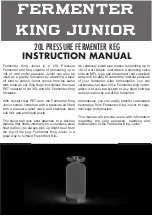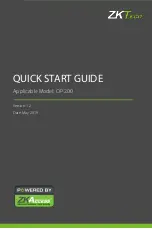
9. CR#32 is used to set RS-485 communication baud rate: 4800, 9600, 19200, 38400, 57600, 115200
bps. b0: 4800bps. b1: 9600bps. (factory setting) b2: 19200bps. b3: 38400 bps. b4: 57600 bps. b5:
115200 bps. b6-b13: reserved. b14: exchange low and high byte of CRC check code. (only for RTU
mode) b15=0: ASCII mode. b15=1: RTU mode. Communication format: ASCII mode is 7Bit, even bit,
1 stop bit (7 E 1). Communication format of RTU mode is 8Bit, even bit, 1 stop bit (8 E 1).
10. CR#33 is used to set the inner function priority. For example: characteristic register. Output latched
function will save output setting in the inner memory before power loss.
11. CR#34 is software version of model type.
12. CR#35~ CR#48 are used for system.
13. The corresponding parameters address H4032~H4063 of CR#0~CR#48 can provide user to
read/write data by RS-485.
A. Communication baud rate: 4800, 9600, 19200, 38400, 57600, 115200 bps.
B. Communication format: ASCII mode is 7Bit, even bit, 1 stop bit (7 E 1). Communication
format of RTU mode is 8Bit, even bit, 1 stop bit (8 E 1).
C. Function code: 03H—read data from register. 06H—write a WORD into register. 10H—write
many WORDs into register.
5
ADJUST D/A CONVERSION CHARACTERISTIC CURVE
5.1
Adjust D/A Conversion Characteristic Curve
Voltage output mode
Mode 0 of CR#1: GAIN = 5V(2000
LSB
),
OFFSET=0V (0
LSB
)
Mode 1 of CR#1: GAIN = 6V(2400
LSB
),
OFFSET=2V (800
LSB
).
GAIN:
The setting range of voltage output value when
digital input value is K2000 should be
-4V~+20V(-1600
LSB
~+8000
LSB
).
OFFSET:
The setting range of voltage output value when
digital input value is K0 should be
-5V~+5V(-2000
LSB
~ +2000
LSB
).
0
+2000
+4000
2V
5V
6V
10V
OFFSET
GAIN
voltage
output
Digital input
mode 0
mode 1
GAIN
-
OFFSET: Setting range: +1V~+15V (+400
LSB
~ +6000
LSB
).
Current output mode
Mode 2 of CR#1: GAIN = 12mA(2400
LSB
),
OFFSET=4mA (800
LSB
).
Mode 3 of CR#1: GAIN = 10mA(2000
LSB
),
OFFSET=0mA (0
LSB
).
GAIN:
The setting range of current output when digital
input value is K2000 should be -8mA~+40mA
(-1600
LSB
~+8000
LSB
).
OFFSET:
The setting range of current output when digital
input value is K0 should be -10mA ~+10mA
(-2000
LSB
~+2000
LSB
).
0
+2000
+4000
20mA
OFFSET
GAIN
12mA
10mA
4mA
current
output
digital input
mode 3
mode 2
GAIN
-
OFFSET: Setting range: +2mA~+30mA (+400
LSB
~+6000
LSB
).
The above charts are D/A conversion characteristic curve of voltage output mode and current
output mode. Users can adjust conversion characteristic curve by changing OFFSET values
(CR#18~CR#21) and GAIN values (CR#24~CR#27) depend on application.
LSB(Least Significant Bit): 1.voltage output:1
LSB
=10V/4000=2.5mV. 2. current output:
1
LSB
=20mA/4000=5µA.
5.2 Program Example for Adjusting D/A Conversion Characteristics Curve
Example 1: Setting OFFSET value of CH1 to 0V(=K0
LSB
) and GAIN value is 2.5V(=K1000
LSB
).
X0
K1000
K24
H10
K1
K1
H0
K1
M1002
K33
K1
K1
K18
K0
TO
TO
TO
TO
K1
K1
K1
K1
Writing H10 into CR#1 of analog
output module#0. Setting CH1 to
mode 0 (voltage output 0V~ +10V),
and set CH2 to mode 2 (current
output 4mA~+20mA).
Writing H0 into CR#33 and allow
CH1~CH4 to adjust characteristics.
When X0 switches from OFF to
ON, K0
LSB
of OFFSET value will be
wrote in CR#18 and K1000
LSB
of
GAIN value will be wrote in CR#24.
Example 2: Setting OFFSET value of CH2 to 2mA (=K400
LSB
) and GAIN value to 18 mA (=K3600
LSB
).
X0
K1
K1
H0
K1
M1002
K33
K1
K1
H18
K19
K25
K400
K3600
TO
TO
TO
TO
K1
K1
K1
K1
Writing H18 into CR#1 of analog
output module#0. Setting CH1 to
mode 0 (voltage output 0V~+10V)
and set CH2 to mode 3 (current
output 0mA~ +20mA).
Writing H0 into CR#33 and allow to
adjust characteristic of CH1~CH4.
When X0 switches from OFF to
ON, K400
LSB
of OFFSET value will
be wrote in CR#19 and K3600
LSB
of
GAIN value will be wrote in CR#25.
6
INITIAL PLC START-UP
Lamp display
1. When power is on, POWER LED will be lit and ERROR LED will be lit for 0.5 second.
2. It is normal that POWER LED should be lit and ERROR LED should turn off. When power supply
is lower than 19.5V, ERROR LED will blink continuously till the power supply is higher than 19.5V.
3. When it connects to PLC MPU in series, RUN LED on MPU will be lit and A/D LED or D/A LED
should blink.
4. After receiving the first RS-485 command during controlling by RS-485, A/D LED or D/A LED
should blink.
5. After converting, ERROR LED should blink if input or output exceeds upper bound or lower than
lower bound.
Program example:
M0
K1
M1000
FROM
END
D0
TO
K0
K1
D0
CMP
H401
INC
D100
ADD
D101
K5
LD=
K4000
RST
H10
K2
K6
M1
M1013
D101
D100
D100
LD=
K4000
RST
D101
D101
K1
K1
K1
TO
M1
K1
D100
Explanation:
Reading the data of model type from expansion module K1 and distinguish if the data is H0401
(DVP04DA-H model type).
D100 will increase K1 and D101 will increase K5 every second.
When value of D100 and D101 attain to K4000, they will be reset to 0.
If the model type is DVP04DA-H, M1 will be on and set the output mode: CH1 mode to 0, CH2 mode
to 2.
Writing output setting CR#6 and CR#7 to D100 and D101. Analog output will change with D100 and
D101 value.
7
COMMAND EXPLANATION
API
Adaptive model
ES
EP
EH
78
D
FROM
P
Read special module
CR data
Bit device
Word device
X Y M S K H KnX KnY KnM KnS T C D E F
m
1
¼
¼
m
2
¼
¼
D
¼
¼
¼
¼ ¼ ¼ ¼
¼
n
¼
¼
Note: The usage range of operand m
1
is 0~7.
The usage range of operand m
2
: ES/EP:
0-48, EH: 0-254.
The usage range of operand n: ES/EP: n=
1~(49-m2), EH: 1~(255-m2).
ES series model doesn’t support pulse
execution command (FROMP, DFROMP).
16-bit command (9 STEPS)
FROM
Continuous
execution
FROMP
Pulse
execution
32-bit command (17 STEPS)
DFROM
Continuous
execution
DFROMP
Pulse
execution
Flag: When M1083=On, it allows to
insert interrupt during FROM/TO.
Refer to following for detail.
Command
Explanation
: the number for special module.
: the number of CR (Control Register) of
special module that will be read.
: the location to save reading data.
: the
data number of reading ONCE.
DVP-series PLC uses this command to read CR data of special module.
: When assigning bit operand, K1~K4 can be used for 16-bit and K5~K8 can be
used for 32-bit.
Please refer the following footnote for calculating of special module number.
Program
Example
To read the content of CR#24 of special module#0 to D0 of PLC and to read the
content of CR#25 of special module#0 to D1 of PLC. It can read 2 data in one time
(n=2).
The command will be executed when X0=ON. The command won’t be executed when
X0=OFF and the content of previous reading data won’t change.
X0
FROM
K0
K24
D0
K2
API
Adaptive model
ES
EP EH
79
D
TO
P
Special module CR
data write in
Bit device
Word device
X Y M S K H KnX KnY KnM KnS T C D E F
m
1
¼
¼
m
2
¼
¼
S
¼
¼
¼
¼
¼
¼
¼
¼
¼
¼ ¼
n
¼
¼
Note: The usage range of operand m
1
is 0~7.
The usage range of operand m
2
: ES/EP:
0-48, EH: 0-254.
The usage range of operand n: ES/EP:
1~(49-m2), EH: 1~(255-m2).
For ES series, it doesn’t support pulse
execution command (TOP, DTOP)
16-bit command (9 STEPS)
TO
Continuous
execution
TOP
Pulse
execution
32-bit command (17 STEPS)
DTO
Continuous
execution
DTOP
Pulse
execution
Flag: When M1083=On, it allows to
insert interrupt during FROM/TO.
Refer to following for detail.
Command
Explanation
: the number of special module.
: the number of CR (Control Register) of
special module that will be wrote in.
: the data to write in CR.
: the data
number to write in one time.
DVP-series PLC uses this command to write data into CR of special module.
: When assigning bit operand, K1~K4 can be used for 16-bit and K5~K8 can be
used for 32-bit.
Program
Example
Using 32-bit command DTO, program will write D11 and D10 into CR#3 and CR#2 of
special module#0. It only writes a group of data in one time (n=1).
The command will be executed when X0=ON and it won’t be executed when
X0=OFF. The data that wrote in previous won’t have any change.
X0
K0
K2
D0
DTO
K1
Footnote
The rule of command operand
m1: arrangement number of special module. The number of special module
that connects to PLC MPU. The numbering order of special module from the
near to the distant of MPU is from 0 to 7. The maximum is 8 special modules
and won’t occupy I/O point.
m2: the number of CR. Built-in 16-bit of 49 groups memory of special module
is called CR (Control Register). The number of CR uses decimal digital
(#0~#48). All running status and setting values of special module have
included.
If using FROM/TO command, the unit of read/write of CR is one number for
one time. If using DFROM/DTO command, the unit of read/write of CR is two
numbers in one time.
CR #10
CR #9
Upper 16-bit Lower 16-bit
Specified CR number
The number of transmission groups n. The meaning of n=2 of 16-bit
command and n=1 of 32-bit are the same.
D0
D1
D2
D3
D4
D5
CR #5
CR #6
CR #7
CR #8
CR #9
CR #10
D0
D1
D2
D3
D4
D5
CR #5
CR #6
CR #7
CR #8
CR #9
CR #10
Specified device
Specified CR
Specified device Specified CR
16-bit command when n=6
32-bit command when n=3
In ES series models, flag M1083 is not provided. When FROM/TO command is
executed, all interrupts (including external or internal interrupt subroutines) will be
disabled. All interrupts will be executed after completing FROM/TO command.
Besides, FROM/TO command also can be executed in the interrupt subroutine.
The function of the flag M1083 (FROM/TO mode exchange) provided in EP/EH
series models:
1.
When M1083=Off, FROM/TO command is executed, all interrupts (including
external or internal interrupt subroutines) will be disabled. All interrupts will
be executed after completing FROM/TO command. Besides, FROM/TO
command also can be executed in the interrupt subroutine.
2. When M1083=On, if an interrupt occurs while FROM/TO command has
been programmed, FROM/TO command will be interruptted to execute the
interrupt. However, FROM/TO command cannot be executed in the
interrupt subroutine.




















